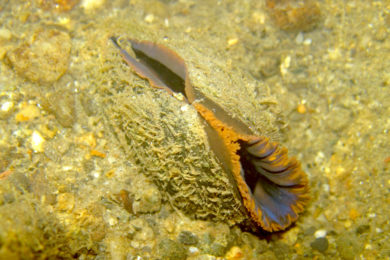Freshwater mussels are recognized as the most endangered group of aquatic organisms in North America, a hotspot for world mussel diversity, with over two-thirds of species considered extinct, endangered, or in need of special protection. In Vermont, 10 of the 18 native species, or 55%, are listed under the state endangered species law, and several others are considered rare. One species, the Dwarf Wedgemussel, is listed as federally endangered. In Vermont only five native species are not considered to be in conservation need.

Eastern Pearlshell (Margaritifera margaritifera) iNaturalist Vermont observation (http://www.inaturalist.org/observations/404474). Photo by Larry Clarfeld
Freshwater mussels need clean water, suitable habitat, and healthy fish assemblages. Vermont’s native mussels are threatened by habitat loss, alteration, and fragmentation from bridge construction, riverbank stabilization, and dams, which have been responsible for dramatic losses of habitat. Bank erosion and storm water runoff can cover mussel beds in sedimentation. The introduced and invasive Zebra Mussel is decimating Lake Champlain mussel populations and the exotic and invasive Asiatic Clams are now found near Vermont. Mussels have been shown to be sensitive to a variety of pesticides and other chemicals. Wastewater effluents, stormwater, and agricultural runoff can carry pollutants into rivers and affect mussel health.
Vermont’s Wildlife Action Plan, a proactive examination of the health of Vermont’s wildlife, provides a blueprint for wildlife conservation for everyone from government agencies, to nonprofit organizations, and private landowners. In Vermont, 13 of the 18 known species are considered ‘Species of Greatest Conservation Need’ by the revised Vermont Wildlife Action Plan (2015). The plan’s two highest priorities are: 1) obtain baseline information on distribution and abundance of each species, include all existing information sources; and 2) conduct inventories to detect and gather information on mussel populations.
Join us to help fulfill these high priority tasks
From the common to the rare, we need your help in recording locations of freshwater mussels in Vermont. Nearly everyone knows what a mussel shell looks like and many of you are armed with a camera. Help us find them.
Surveying for freshwater mussels, especially across an entire state, is costly and can require extensive technical training as well as specialized skills, such as SCUBA in some cases. During this first phase of the Vermont Freshwater Mussel Survey, we will employ trained citizen scientists to help us conduct rapid inventories of a broad range of areas that are identified as lacking in surveys based on past data.
Citizen scientists will be recruited and trained in identification and surveying using shoreline and shallow water searches. Volunteers will be assigned riverbanks or lakeshores to walk and search for shells. This method is a safe and easy way to determine what lives in a water body and allows volunteers to easily photograph shells for later verification without disturbing or collecting any live mussels. Any areas found to have conservation concern species or a high diversity of species will be visited by biologists to further determine the status of the living population.
Attend Our Freshwater Mussel Workshop on July 15th
Hosted by the Vermont Center for Ecostudies and Vermont Fish & Wildlife, join us at the North Branch Nature Center in Montpelier from 10AM to 2PM on Saturday, July 15th. This workshop will teach participants the basics of freshwater mussel biology, identification, how to conduct shoreline surveys and submit your data to our Vermont Freshwater Mussel Survey project on iNaturalist.
Please register to attend this workshop. And then get out and help us survey waterways for these incredible aquatic animals. For more information, contact Lyra Brennan at .


Sept 21st 2017 I found 2 different white looking clams/mussles dead in a Vermont stream that had dried up. I went on line to see if VT really had these shelled creatures and to my surprise I found out they are endangered!
Nice photo of your state mussels….wish they had names attached!
Hi Brian, while the image doesn’t have all the names with it, you can see images and more for the species here: https://val.vtecostudies.org/projects/vermont-freshwater-mussel-atlas/species/. I I will put on my list to create a key to that image! Thanks.